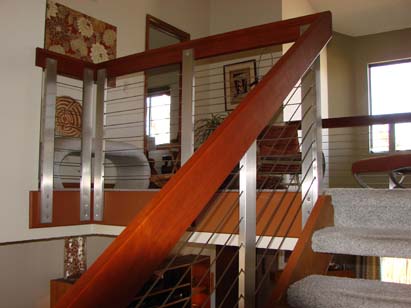In April 2008, we were contacted by Jerry K., a homeowner in Littleton, Colo. His townhome included a loft with wood picket railing, which did a pretty good job of enclosing both the loft itself and the stairway to it, making the interior space of the home’s living area feel pretty confined. Jerry’s son, who was pursuing a degree in industrial design at the time, helped with design, sending us CAD drawings of what they were trying to accomplish. We worked with their needs to map out for him what fittings would go where based on the floor plan and the metal posts that would replace the wood balusters.
Roadrunner Fabrication in Denver machined the 23 posts for the rail remodel and Jerry and his son installed them, along with a freshly routed, stained, and varnished cherry handrail.
The project went to back-burner status while the economy turned south for a few years, but in December 2012, Jerry contacted us again and we picked up where we left off. We re-quoted the job two ways, with swageless fittings (more expensive than swaged but convenient to use) and with swaged fittings (less expensive than swageless but more labor-intensive if swaging is done on-site).
After a few more months of design Q&A and figuring out exactly how to make the whole system work (in addition to the steel posts, there was a section that terminated into the wood stringer of one of the stairs), it was decided that the best way to go would be to cut and swage the cables on-site. Since Jerry wanted to see as little hardware as possible, most of the runs were terminated with Ultra-tec’s Invisiware Receivers, which hide inside the post.
We shipped the hardware and swager separately, per Jerry’s request, so they could pre-string cable and have everything ready for the arrival of the swager to crimp the cables. That was a good idea, because he and his son discovered they had misplaced some of the holes they had their fabricator pre-drill (four years earlier) in their stair posts. Fortunately, Roadrunner Fabrication was able to fill the misplaced holes and drill the new ones to make the posts look good as new.
After four years in the design and making, it only took a day and a half to install the 55 cables and associated fittings. Knowing they were doing their own swaging, we included a few extra fittings – which turned out to be exactly how many they accidentally squashed while on the swager learning curve.
The results speak for themselves, as the photos reflect. Jerry is very pleased with the result, and proudly displays the project on which he and his son collaborated.









